You’ve completed the job — now, only one thing stands in the way of getting paid: sending a business invoice.
Here at PandaDoc, thousands of invoices have come across our desk, which means we can recognize an effective invoice from a poorly constructed one by this point.
We even have a custom invoicing software of our own, so you could say we know a thing or two about invoicing.
In this article, you’ll find our step-by-step guide on how to prepare invoices, ensure they are properly filled out, and how to submit them.
What does an invoice look like?
An invoice is a structured document that usually has a header section with your company information.
Everything below is dedicated to a specific customer ID followed by a detailed list of products or services you’ve provided and a complete summary of the total amount due.
How to write an invoice
Simply write your business name, contact information, and add your company logo at the top.
Below that, list the customer’s details, the date, and a description of the products or services (you can use PandaDoc pricing tables).
Last, you can include an electronic signature field and integrated payment options.
→DOWNLOAD NOW: FREE INVOICE TEMPLATE
1. Brand your invoice in the header
Branding your invoices can help build your reputation, support marketing, differentiate yourself from competitors, and showcase professionalism.
You can do this by including your logo and distinct brand features on your invoices.
Simply place your logo in the header and use brand-specific colors and fonts throughout the document.
Consistent branding helps increase familiarity with, and fondness for, your brand. If you don’t have a logo, you can hire a freelancer on Upwork or Fiverr to design one. Even a personal brand can have a stylish and effective logo. Alternatively, consider including a headshot.
2. Include your contact details
Your invoice should prominently display your contact information, including your name, phone number, email address, and business address, as it is legally required.
Also, consider using a specific phone number or email address for invoicing to ensure prompt responses to customer queries.
How to include your contact details using PandaDoc:
1. Add a text block to the template.
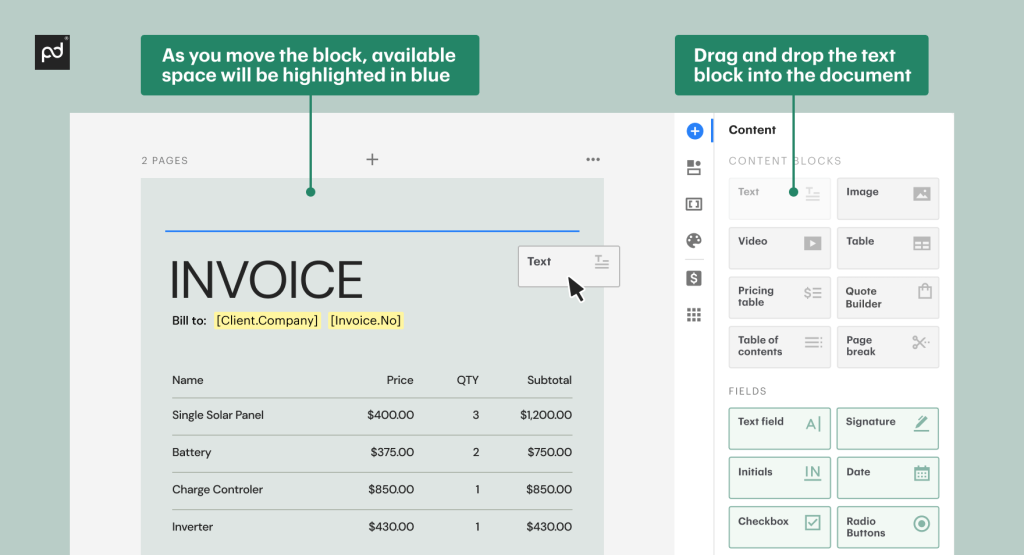
2. Type your contact information into the box.
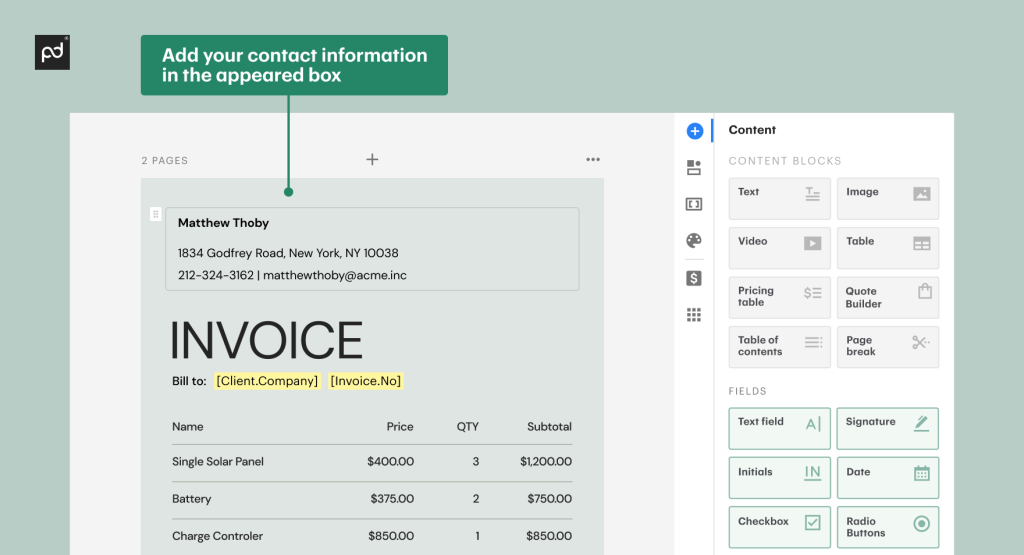
3. List your company name and information
Including your business name on invoices is essential to avoid getting lost among other invoices. Place it prominently near the top, along with any business registration number.
Clear identification will help recipients know exactly who the invoice is from, even when they have many others to review.
How to include your company information using PandaDoc:
1. Add an image block.

2. Upload your company logo.
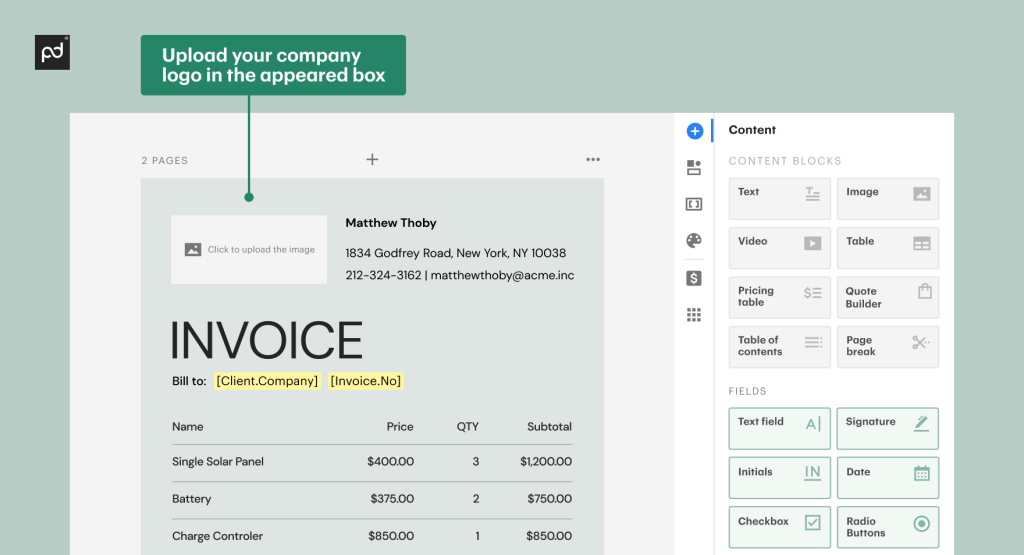
3. Here’s how the finalized version will look like:
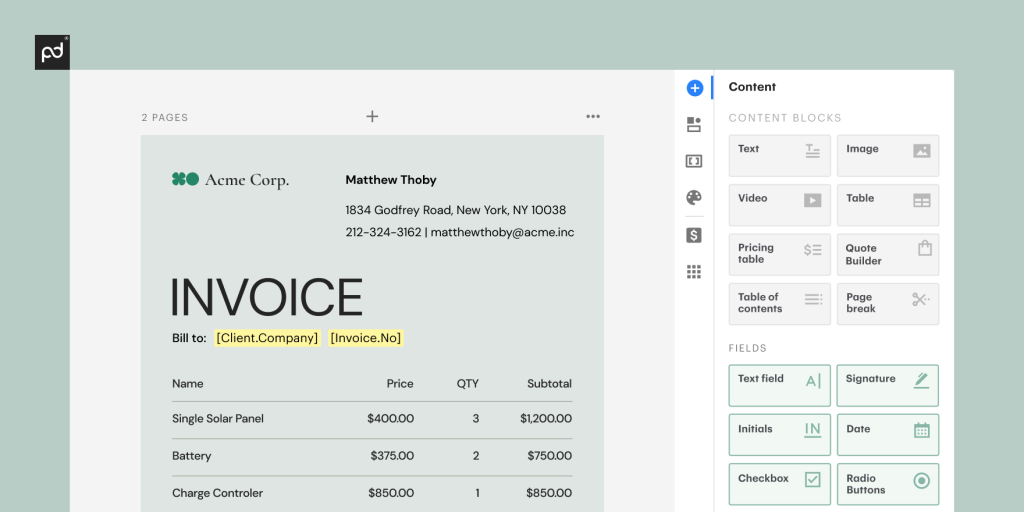
4. Write a description of the goods or services you’re charging for
Descriptions don’t need to be the length of a novel, but they should have enough detail for your customers to know exactly what it is they’re paying for.
You’ll want to add descriptions for each separate good or service on your invoice so that every item is clear.
Invoices that lack clarity when it comes to the goods or services descriptions lead to more questions from customers, which can add up to frustrated clients and bigger delays in receiving payment.
Our library provides many payment invoice examples that you can easily customize by adding drag and drop price tables.
This allows for quick and efficient detailing of each item or service, including the price, quantity, rate, hours and description. Additionally, PandaDoc automatically saves and stores all invoices sent on our servers.
5. Add the dates
Dates add context to an invoice and make the whole document more clear for your customers. It also gives reference points that you and your client can use as a touchstone when it comes to payment due dates.
Most importantly, you’ll want to add:
- The date you supplied your goods or services
- The issue date of the invoice
Many professional invoices will commonly list the submission date near the top of the invoice and incorporate the supply date near the description of goods and services.
Including accurate dates will ensure your customers know exactly when you completed work for them or sold them certain goods and when the invoice has been issued.
→DOWNLOAD NOW: FREE INVOICE TEMPLATE
6. Total up the money owed
Along with the description of goods or services provided, you’ll need to include the amounts owed for each item.
To the right of each item, you’ll include the subtotal — the amount of each individual item.
As you move further down the invoice line by line, you’ll gradually total up these amounts for a grand total amount due.
This final amount should be clearly listed near the bottom of the invoice as a total cost.
Double and triple-check your amounts and ensure that you’ve added all necessary taxes and the total amount owed is correct.
7. Explain acceptable payment terms
Now it’s time to define the payment instructions on invoices you send out.
Ideally, payment terms should be discussed with the customer before the rendering of goods or services and mutually agreed upon; still, you’ll want to add an invoice note that lists these terms clearly.
What should an invoice include in terms of payment options?
That depends on whether you will accept cash, credit card, check, or online payments — or different payment providers like PayPal.
Here’s a list of some of the most common payment options business owners include on their invoices:
- Cash
- Credit or debit card
- Check
- Bank transfer
- Online payments
- Mobile payments
- Automatic payments
If you want payment to go directly to a bank account then you’ll need to supply banking details on the invoice as well.
All of these different payment options have their pros and cons, such as conveniences and fees, so carefully consider which ones you’ll include.
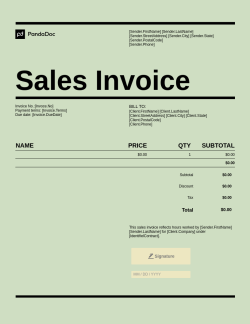
Sales Invoice Template
Used 5437 times
Use this professional sales invoice template as a sample on which to base all the sales invoicing of your product or service.
Use this template8. Choose your payment method
Here are some factors to weigh as you request payment:
Cost
When assessing a payment method, consider how much it will cost your business to use it.
Most credit card processing options charge transaction fees when you accept card payment.
Additional costs may come in the form of hardware if you’re accepting in-person credit card payments and mobile payments.
Convenience
Think about how easy it is to accept the payment methods you’re considering.
For example, checks typically require a trip to the bank to deposit your money and banks often put a hold on the funds for several days.
On the other hand, online payment options require little to no work on your part and the money will show up in your bank account within a couple of days.
Security
Every payment method you allow should be secure for the sake of your business and your customers. Cash is relatively insecure since it’s subjected to the risk of theft and loss.
Online payments through secure vendors offer fairly high levels of security and encryption so that your client is protected and you receive your payment without hiccups.
Client Preferences
Your clients likely have their own preferences when it comes to issuing payment, so you’ll want to consider which methods will be easiest and safest for them to use.
Perhaps it might be worthwhile to informally survey a few of your clients to see if they have any preferred options for billing or ask them in the early planning stages.
Besides payment methods, list whether or not you have a timeframe that you expect payment in so that your customer is clearly aware of the due date.
If you’ll accept payment in portions or in some sort of payment plan, specify this clearly.
The more straightforward you can make your payment terms, the better. Your customers are less likely to be confused and more prone to issue payments on time and in the format that you want.
What is a VAT invoice, and how do you issue one?
The acronym VAT stands for value-added tax, which is a consumption tax used across the European Union and in other countries.
VAT is used in more than 160 countries worldwide and applied to goods, services, and other taxable supplies.
Customers in the EU pay VAT at the time of purchase for each product or service they buy, and the specific VAT varies based on the member state.
If you’re VAT-registered, then you need to be using VAT invoices. The exception to this is if your customer in the EU has a valid VAT number; then you don’t need to charge them VAT on your invoices.
Businesses with valid VAT numbers in the EU are responsible for filing their own VAT. They can then be reimbursed for the VAT charged on products and services that they purchase and use to run their business.
The main difference between a standard invoice and a VAT invoice is the amount of information required.
The exact information varies on the type of VAT invoice you’re issuing, but in general, it should include all of the same information from a standard invoice, plus:
- Your VAT registration number
- The date of supply (or tax point) if it’s different than the invoice date
- The VAT rate and total VAT charged per item (unless all items are charged at the same tax rate)
- If different items have different VAT rates, then show the rate for each item
- The unique invoice number
- The client’s name and address
- The client’s VAT number, if applicable (If your client has a VAT number, you should then include the text “EU VAT Reverse Charged” on your invoice)
- The currency applied
VAT invoices may seem more complicated than a standard invoice at first glance, but they’re actually fairly similar at the end of the day.
With PandaDoc’s pricing table feature, incorporating VAT is a breeze when you invoice thanks to the easily editable and separate line items.

VAT Invoice Template
Used 5029 times
You can create invoices based on your design layouts, set recurring invoices, send automated payment reminders and late fees with this VAT Invoice template.
Use this template9. Send your invoice
Once you have gathered all the necessary information, you can proceed to send invoices to your customers.
While sending an invoice via email as a PDF attachment is a common practice to prevent fraudulent manipulation, it may not be the most efficient way.
This is because you can’t always tell whether the customer has viewed the invoice, which could result in late payments.For this, you can set reminder nudges to keep an eye.
Additionally, using electronic signatures provides an added layer of security, guaranteeing the authenticity of each document and minimizing the risk of fraud.
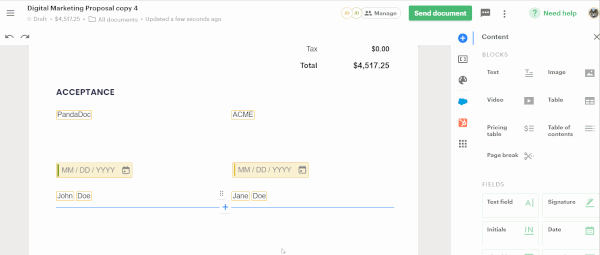
You can also request a paid-in-full invoice from your customers signed by both parties to keep a written record of all your transactions.
Final thoughts on invoicing
Creating an invoice should be a simple process once you have established an effective routine using templates best suited for your needs.
You can choose the right sample of invoice for payment template from our extensive library to save time in document management.
If you want to see how we can benefit your business and streamline your invoicing process, get in touch with our representatives to start the demo today.
Disclaimer
PandaDoc is not a law firm, or a substitute for an attorney or law firm. This page is not intended to and does not provide legal advice. Should you have legal questions on the validity of e-signatures or digital signatures and the enforceability thereof, please consult with an attorney or law firm. Use of PandaDocs services are governed by our Terms of Use and Privacy Policy.
Originally published February 14, 2017, updated June 20, 2023


